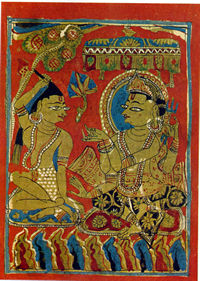
The Consecration of Mahavira. Gujarat, 1404. Miniature from Jaina manuscript, the Kalpasutra. 7×10 cms. Collection: British Museum, London. Mahavira is the figure on the left; here he is shown decked in jewelery, but teaching about his hair.
The changes in economic life during the seventh century BC, such as the growth of towns and the rapid development of trade, were linked to religious and philosophical speculation. The conflict between the established Hindu orthodoxy and the aspirations of the newly emergent groups in the towns gave rise to various heterodoxies, from determinism to materialism. However, only two of these ‘sects’ were to endure, namely Buddhism and Jainism.
Jaina ideas can be traced back to the seventh century, though it was Mahavira who formalized the philosophy of what was to be known as Jainism in the sixth century. Mahavira, most likely born around 540 BC, was a Kshatriya of high Licchavi tribal birth. At the age of 30, he renounced family life and proceed to live, for the next 12 years, as an ascetic. He abandoned even clothes to go naked
Jainism is atheistic in nature as the existence of God is irrelevant to its doctrine. The Jains postulate the existence of a soul for everything, including non-living things. The vow of non-violence, or ahimsa, was of paramount importance to the Jaina, since even the unconscious killing of an insect while walking or breathing was a sin. (Orthodox Jain monks can still be observed wearing a net over their mouth, and they gently sweep the street as they walk to remove insects from their path, lest they should inadvertently crush them.) The purification of the soul was conceived as the purpose of living. Contrary to what the Upanishads or Hindu philosophical texts suggests, Jains were inclinced to believe that this purification could not be attained by knowledge, but only through living a balanced life.
Mahavira’s teaching was confined to the Ganges valley and until the third century BC remained an oral tradition. The emphasis on non-violence prevented farmers from being Jains, since cultivation involved killing pests. However, Jainism spread among the traders and thus came to be associated with the spread of urban culture. Even today, Jains are associated with business, but they are also prominent in learning, and many of the most notable publishing houses in India, such as the renowned Indological booksellers Motilal Banarsidass, are owned and managed by Jains.
In later years, Jainism moved to western India, where even today there are around two million Jains. Gandhi was deeply influenced by Jain religious thought and practices, and his advocacy of ahimsa, and his frequent recourse to fasting, owes a good deal to the Jaina philosophy. Jainism also spread to parts of Mysore in South India, a testament of which is the gigantic statue of a tirthankara (one of the 24 great Jaina teachers) at Sravanbelagola in near proximity to Mysore.
In later centuries, Jainism would undergo many changes. The strict rule against possessing property enforced by Mahavira was interpreted to mean only landed property. The Jains also divided into the orthodox Digambara (sky-clad, i.e, naked) sect and the more liberal Shvetambara (white-clad) sect. Important places of pilgrimage were to develop among the Jainas, among which Mt. Abu in Rajasthan and Sravanabelogola are prominent.

